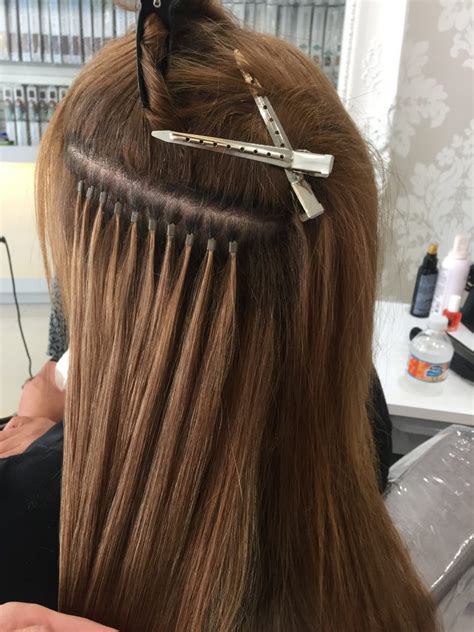Indulge in the transformative power of human hair extensions with our comprehensive guide to sew-in techniques. Discover everything you need to know, from choosing the right extensions to achieving seamless results.

Benefits of Human Hair Extensions
- Natural Appearance: Human hair extensions blend seamlessly with your own hair, creating a natural and realistic look.
- Long-Lasting: Sew-in extensions can last for months with proper care, giving you a long-lasting boost in volume and length.
- Versatile: Sew-in extensions can be styled and colored just like your natural hair, allowing for endless possibilities.
- Damage-Free: Sew-in techniques involve attaching the extensions to your own hair without using glue or chemicals, minimizing damage.
Choosing the Right Extensions
Hair Type: Match the hair type of the extensions to your own for a cohesive look. Choose extensions that are Remy hair (cuticles aligned) for optimal quality.
Color: Select extensions that closely match your natural hair color to prevent obvious transitions. Consult with a professional colorist for precise matching.
Length: Determine the desired length of your extensions based on your personal preferences. Consider the length of your own hair and the overall style you want to achieve.
Quantity: The number of extensions needed depends on the desired fullness. For a natural look, 12-16 wefts is generally sufficient.
Sew-In Techniques
Machine Sew-In:
- Section off the desired area of hair.
- Use a sewing machine with a C-curved needle to attach the wefts to the natural hair strands.
- Sew the wefts close to the root, but not too tightly to avoid damage.
Hand-Sewn:
- Divide the hair into small sections and braid them.
- Sew the wefts to the braids using a needle and thread.
- Secure the thread tightly around the braid to hold the weft in place.
Micro-Link Sew-In:
- Insert a metal bead into a small section of natural hair.
- Fold the weft over the bead and secure it with a special tool.
- Repeat the process along the desired area of hair.
Step-by-Step Approach
- Prepare the Hair: Wash and blow-dry your natural hair to remove any oils or products.
- Section and Braid: Divide your hair into small sections and braid them tightly.
- Select and Sew: Choose the desired extension wefts and sew them securely to the braids.
- Style and Blend: Style the extensions to match your own hair and use a blending spray to create a seamless transition.
Care and Maintenance
- Wash your extensions every 2-3 weeks with sulfate-free shampoo and conditioner.
- Use a wide-toothed comb to detangle the extensions while wet.
- Avoid using heat styling tools at high temperatures to prevent damage.
- Get regular trims to maintain the length and shape of the extensions.
Strategies for Successful Sew-In Extensions
- Consult with a professional hair stylist for expert advice.
- Choose high-quality extensions from reputable suppliers.
- Invest in proper care and maintenance products.
- Experiment with different styling techniques to achieve the desired look.
- Be patient and take care not to damage your natural hair.
Data and Statistics
- According to the American Hair Loss Association, over 50% of women experience hair loss at some point in their lives.
- The global hair extension market is projected to reach $10.44 billion by 2028 (Grand View Research, 2023).
- Human hair extensions account for the largest share of the hair extension market, due to their natural appearance and versatility.
Testimonials
“I was hesitant at first, but the sew-in extensions I got have completely transformed my hair. They’re so natural-looking and blend perfectly.” – Amy, satisfied client
“I’ve tried different types of extensions before, but sew-in extensions are by far the most comfortable and long-lasting.” – Sarah, repeat customer
Tables
Table 1: Comparison of Sew-In Techniques
| Technique | Cost | Time | Appearance | Damage |
|---|---|---|---|---|
| Machine Sew-In | Moderate | Quick | Less natural | Moderate |
| Hand-Sewn | High | Time-consuming | Most natural | Minimal |
| Micro-Link Sew-In | High | Moderate | Seamless | Minimal |
Table 2: Factors to Consider When Choosing Hair Extensions
| Factor | Considerations |
|---|---|
| Hair Type | Match your own hair texture (straight, wavy, curly) |
| Color | Choose extensions that closely resemble your natural hair color |
| Length | Determine the desired length of the extensions |
| Quantity | Determine the desired fullness of the extensions |
Table 3: Care and Maintenance Tips for Sew-In Extensions
| Tip | Frequency |
|---|---|
| Washing | Every 2-3 weeks |
| Conditioning | After every wash |
| Detangling | While wet, using a wide-toothed comb |
| Heat Styling | Use low temperatures and apply heat protectant spray |
| Trims | Every 8-12 weeks |
Table 4: Strategies for Successful Sew-In Extensions
| Strategy | Purpose |
|---|---|
| Professional Consultation | Expert advice on extensions and placement |
| High-Quality Hair | Invest in long-lasting, natural-looking extensions |
| Dedicated Maintenance | Follow recommended care and maintenance practices |
| Styling Experimentation | Try different styles to achieve the desired look |
| Patient and Careful Approach | Avoid damaging your natural hair during the installation process |
